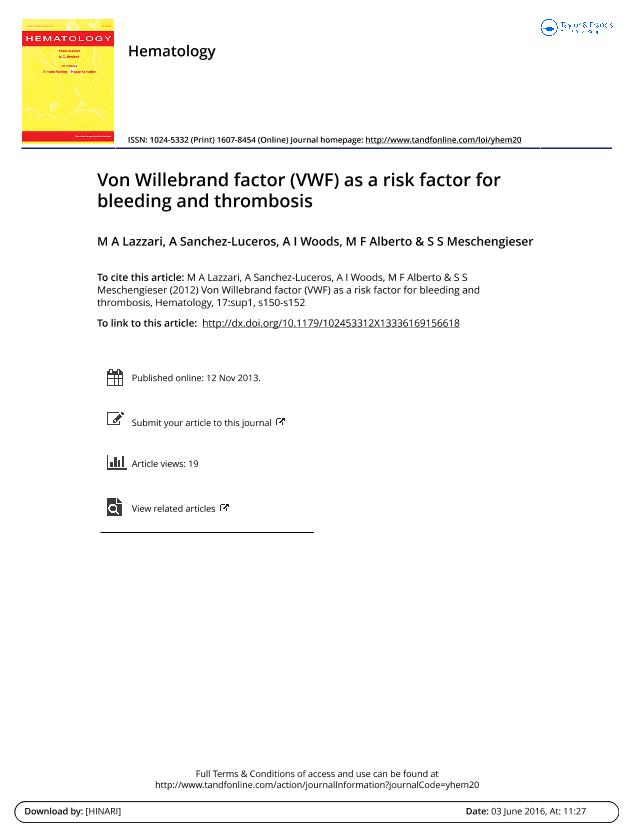Mostrar el registro sencillo del ítem
dc.contributor.author
Lazzari, María Ángela

dc.contributor.author
Sánchez Luceros, Analía Gabriela

dc.contributor.author
Woods, Adriana Inés

dc.contributor.author
Alberto, Maria Fabiana

dc.contributor.author
Meschengieser, Carolina

dc.date.available
2019-12-04T20:44:46Z
dc.date.issued
2012-04
dc.identifier.citation
Lazzari, María Ángela; Sánchez Luceros, Analía Gabriela; Woods, Adriana Inés; Alberto, Maria Fabiana; Meschengieser, Carolina; Von Willebrand factor (VWF) as a risk factor for bleeding and thrombosis; Maney Publishing; Hematology; 17; SUPPL. 1; 4-2012; 150-152
dc.identifier.issn
1024-5332
dc.identifier.uri
http://hdl.handle.net/11336/91421
dc.description.abstract
The von Willebrand factor (VWF) is analysed as a bleeding and thrombotic risk marker. When the VWF level is increased, it predicts a thrombotic phenotype and when VWF level is low in plasma, the phenotype varies to bleeding disorder. But it is quite challenging to define when the level is low, normal or high taking into account that these values are capricious and overlap. This matter should be solved by extensive epidemiologic studies. VWD is a hereditary disorder with several described mutations. VWF is a major acute-phase reactant, besides the physiological conditions such as blood group and pregnancy that affect plasmatic VWF levels. Subjects with O blood group have 25% less VWF than those of non O blood groups, and the latter show higher thrombus burden. VWF would be sensitive though not specific diagnostic marker of myocardial infarction. For the assessment of bleeding severity there are special surveys, scores and pictorial charts. The identification of VWF as a thrombotic risk marker has not been clearly established yet, but it has been involved in stroke and coronary disease. We only have the specific replacement therapy for the bleeding phenotype and we can speculate that enoxaparin and PEG-hirudin are able to blunt the VWF rise in patients with unstable angina pectoris and it is associated with a more favourable clinical outcome. Only two questions remain: does VWF as a bleeding risk marker have the same value as a thrombotic risk marker? Will successful treatments like those achieved for bleeding be also possible in the future for thrombosis?.
dc.format
application/pdf
dc.language.iso
eng
dc.publisher
Maney Publishing

dc.rights
info:eu-repo/semantics/openAccess
dc.rights.uri
https://creativecommons.org/licenses/by-nc/2.5/ar/
dc.subject
BLEEDING PHENOTYPE
dc.subject
PHYSIOLOGICAL VARIATIONS
dc.subject
RISK MARKER
dc.subject
THROMBOSIS
dc.subject
VWF
dc.subject.classification
Hematología

dc.subject.classification
Medicina Clínica

dc.subject.classification
CIENCIAS MÉDICAS Y DE LA SALUD

dc.title
Von Willebrand factor (VWF) as a risk factor for bleeding and thrombosis
dc.type
info:eu-repo/semantics/article
dc.type
info:ar-repo/semantics/artículo
dc.type
info:eu-repo/semantics/publishedVersion
dc.date.updated
2019-09-20T14:15:47Z
dc.journal.volume
17
dc.journal.number
SUPPL. 1
dc.journal.pagination
150-152
dc.journal.pais
Reino Unido

dc.journal.ciudad
Londres
dc.description.fil
Fil: Lazzari, María Ángela. Consejo Nacional de Investigaciones Científicas y Técnicas; Argentina. Academia Nacional de Medicina de Buenos Aires; Argentina
dc.description.fil
Fil: Sánchez Luceros, Analía Gabriela. Consejo Nacional de Investigaciones Científicas y Técnicas; Argentina. Academia Nacional de Medicina de Buenos Aires; Argentina
dc.description.fil
Fil: Woods, Adriana Inés. Consejo Nacional de Investigaciones Científicas y Técnicas; Argentina. Academia Nacional de Medicina de Buenos Aires; Argentina
dc.description.fil
Fil: Alberto, Maria Fabiana. Consejo Nacional de Investigaciones Científicas y Técnicas; Argentina. Academia Nacional de Medicina de Buenos Aires; Argentina
dc.description.fil
Fil: Meschengieser, Carolina. Consejo Nacional de Investigaciones Científicas y Técnicas; Argentina. Academia Nacional de Medicina de Buenos Aires; Argentina
dc.journal.title
Hematology

dc.relation.alternativeid
info:eu-repo/semantics/altIdentifier/doi/https://doi.org/10.1179/102453312X13336169156618
dc.relation.alternativeid
info:eu-repo/semantics/altIdentifier/url/https://www.tandfonline.com/doi/full/10.1179/102453312X13336169156618
Archivos asociados
